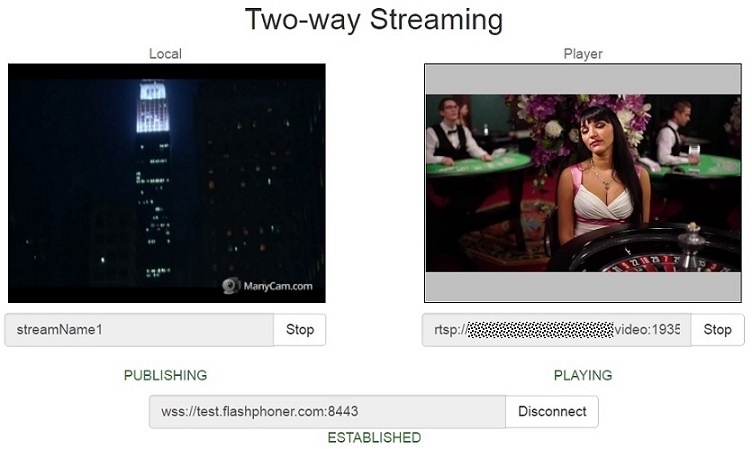Example with streamer and player on the same page
This example demonstrates how to publish a video stream while playing another one using the same web page.
Code of the example
The path to the source code of the example on WCS server is:
/usr/local/FlashphonerWebCallServer/client/examples/demo/streaming/two_way_streaming
two_way_streaming.css - file with styles
two_way_streaming.html - page of the client
two_way_streaming.js - script providing functionality for the example
This example can be tested using the following address:
https://host:8888/client/examples/demo/streaming/two_way_streaming/two_way_streaming.html
Here host is the address of the WCS server.
Analyzing the code
To analyze the code, let's take the version of file two_way_streaming.js with hash ecbadc3, which is available here and can be downloaded with corresponding build 2.0.212.
1. Initialization of the API.
Flashphoner.init() code
Flashphoner.init();
2. Connection to server.
Flashphoner.createSession() code
Flashphoner.createSession({urlServer: url}).on(SESSION_STATUS.ESTABLISHED, function(session){
...
}).on(SESSION_STATUS.DISCONNECTED, function(){
...
}).on(SESSION_STATUS.FAILED, function(){
...
});
3. Receiving the event confirming successful connection
ConnectionStatusEvent ESTABLISHED code
Flashphoner.createSession({urlServer: url}).on(SESSION_STATUS.ESTABLISHED, function(session){
setStatus("#connectStatus", session.status());
onConnected(session);
}).on(SESSION_STATUS.DISCONNECTED, function(){
...
}).on(SESSION_STATUS.FAILED, function(){
...
});
4. Video streaming.
session.createStream(), publish() code
When stream is created, the following parameters are passed
- streamName - name of the stream
- localVideo - <div> element, in which video from camera will be displayed
session.createStream({
name: streamName,
display: localVideo,
cacheLocalResources: true
...
}).publish();
5. Receiving the event confirming successful streaming
StreamStatusEvent PUBLISHING code
session.createStream({
name: streamName,
display: localVideo,
cacheLocalResources: true
...
}).on(STREAM_STATUS.PUBLISHING, function(stream){
setStatus("#publishStatus", STREAM_STATUS.PUBLISHING);
onPublishing(stream);
}).on(STREAM_STATUS.UNPUBLISHED, function(){
...
}).on(STREAM_STATUS.FAILED, function(){
...
}).publish();
6. Stream playback
session.createStream(), play() code.
When stream is created, the following parameters are passed
- streamName - name of the stream (including the stream published on step above)
- remoteVideo - <div> element, in which video playback will be displayed
session.createStream({
name: streamName,
display: remoteVideo
...
}).play();
7. Receiving the event confirming successful stream playback
StreamStatusEvent PLAYING code
session.createStream({
name: streamName,
display: remoteVideo
...
}).on(STREAM_STATUS.PLAYING, function(stream) {
setStatus("#playStatus", stream.status());
onPlaying(stream);
}).on(STREAM_STATUS.STOPPED, function() {
...
}).on(STREAM_STATUS.FAILED, function() {
...
}).play();
8. Stream playback stop
stream.stop() code
function onPlaying(stream) {
$("#playBtn").text("Stop").off('click').click(function(){
$(this).prop('disabled', true);
stream.stop();
}).prop('disabled', false);
$("#playInfo").text("");
}
9. Receiving the event confirming successful playback stop
StreamStatusEvent STOPPED code
session.createStream({
name: streamName,
display: remoteVideo
...
}).on(STREAM_STATUS.PLAYING, function(stream) {
...
}).on(STREAM_STATUS.STOPPED, function() {
setStatus("#playStatus", STREAM_STATUS.STOPPED);
onStopped();
}).on(STREAM_STATUS.FAILED, function() {
...
}).play();
10. Streaming stop
stream.stop() code
function onPublishing(stream) {
$("#publishBtn").text("Stop").off('click').click(function(){
$(this).prop('disabled', true);
stream.stop();
}).prop('disabled', false);
$("#publishInfo").text("");
...
}
11. Receiving the event confirming successful streaming stop
StreamStatusEvent UNPUBLISHED code
session.createStream({
name: streamName,
display: localVideo,
cacheLocalResources: true
...
}).on(STREAM_STATUS.PUBLISHING, function(stream){
...
}).on(STREAM_STATUS.UNPUBLISHED, function(){
setStatus("#publishStatus", STREAM_STATUS.UNPUBLISHED);
onUnpublished();
}).on(STREAM_STATUS.FAILED, function(){
...
}).publish();
12. Sendig data bound to the stream
stream.sendData() code
function onPublishing(stream) {
...
$('#sendDataBtn').off('click').click(function(){
var streamData = field('streamData');
stream.sendData(JSON.parse(streamData));
}).prop('disabled',false);
}
13. Receiving data bound to the stream
STREAM_EVENT, STREAM_EVENT_TYPE.DATA code
session.createStream({
name: streamName,
display: remoteVideo
}).on(STREAM_STATUS.PENDING, function (stream) {
...
}).on(STREAM_STATUS.PLAYING, function (stream) {
...
}).on(STREAM_STATUS.STOPPED, function () {
...
}).on(STREAM_STATUS.FAILED, function (stream) {
...
}).on(STREAM_EVENT, function(streamEvent) {
switch (streamEvent.type) {
case STREAM_EVENT_TYPE.DATA:
addPayload(streamEvent.payload);
break;
}
console.log("Received streamEvent ", streamEvent.type);
}).play();
